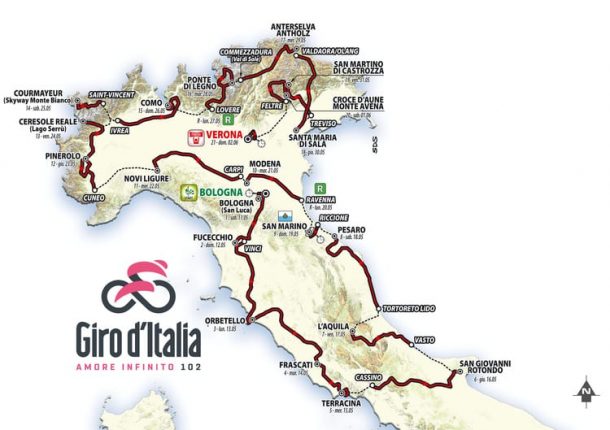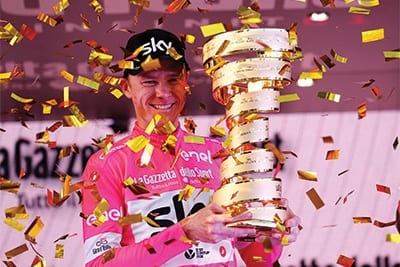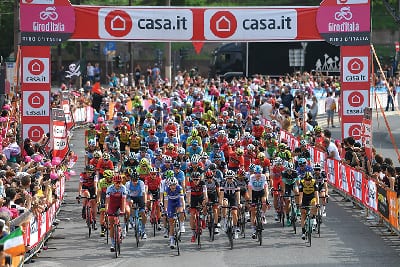Milan, 1908. Sports daily La Gazzetta dello Sport is in dire financial straits. The boss is looking for ideas, and quick. Enter one Armando Cougnet, who, in 1898, aged 18, had cycled from Reggio Emilia to Milan to take up a position with the pink-papered publication
Armando had twice followed the Tour de France in his role and witnessed how effective a marketing tool it had proved to be for the Parisian newspaper L’Auto. La Gazzetta’s competition, Il Corriere della Sera, had, along with Bianchi bicycles and the Italian Touring Club, already been mooting a similar venture to L’Auto.
With Milano-San Remo and the Giro di Lombardia already furnishing its bike race patronage stable, la Gazzetta made sure it struck first and announced the inaugural Giro d’Italia would be held in May – to avoid a clash with the French race – of 1909. It would be another 22 years, however, until the race leader’s iconic ‘Maglia Rosa’ [Pink Jersey] would make an appearance, coloured to match the newspaper’s printed sheets, just as the Tour de France’s ‘Maillot Jaune’ had taken its hue from the yellow pages of L’Auto.
And so it was that 127 adventurers, labourers, racers and chancers took to the start-line in Milan for the 8-stage, 2448km race on 13th May 1909; the first stage alone covered nigh on 400km – but was followed by two rest days.

18 days later, with the usual de rigueur cycle-race shenanigans and chaos of the time (not least surreptitious train journeys for the tired-limbed yet creative-minded, an in-race chicken leg snack putting paid to one poor chap’s chances), 49 exhausted souls, only five of whom were non-Italians, returned to Milan in the wake of Luigi Ganna, the Giro d’Italia’s first winner. Ganna’s victory was sealed by the then-used points system, rather than by time, a system which, if it had been used, would have seen him finish third. A bricklayer by trade, Ganna was asked by Cougnet how he felt in his great moment of triumph: “My arse is killing me!” exclaimed the brutish, newly-crowned Campione.
Italy had fallen hopelessly in love with both the bicycle and the race that drew the fledging nation together – at least in a sporting and geographic manner, while socially and politically there was still much work to be done.
The 2019 Giro d’Italia route has been unveiled in Milan, with the 102nd edition of the Corsa Rosa offering a finely balanced but testing route that includes three individual time trials and five mountain finishes. The winner of the maglia rosa will be crowned in the Verona amphitheatre after a decisive 15.6km time trial.
After the Israel Grand Partenza of 2018, the 2019 Giro d’Italia will stay in Italy, apart from a brief visit to the enclave Republic of San Marino for the uphill finish of the stage 9 time trial. The 21 stages cover a total distance of 3,518km, with the start in Bologna, on Saturday 11th May, and the finish in Verona, on Sunday 2nd June.
Italy had fallen hopelessly in love with both the bicycle and the race that drew the fledgling nation together – in a sporting and geographic manner at least; socially and politically there was still much work to be done
The route includes legendary climbs such as the Passo Gavia, the Passo del Mortirolo and the Passo Manghen, and other lesser-known climbs that are equally as tough. Stage 13 ends with the stunning Colle del Nivolet up to Lake Serru’, while stage 14 is short, at just 131km, with four steep climbs, including the Colle San Carlo – a twisting 10.5km climb at 9.8 per cent. Stage 15 to Como is a replica of the Il Lombardia finale with the Ghisallo Colma di Sormano and Civiglio.

The final week offers just one chance for the few sprinters that are expected to be left in the race, with the final mountain stages to Ponte di Legno – which includes the Passo del Mortirolo just 27km from the finish – Anterselva, San Martino di Castrozza in the shadow of the Dolomites and then the Croce d’Aune, the day before the conclusive Verona time trial.
Defending champion Chris Froome (Team Sky) was at the presentation in Milan, where the audience watched a video highlighting his incredible attack over the dirt road Colle delle Finestre and 80km solo ride to Jafferau above Bardonecchia.
Froome was diplomatically coy about returning to defend the Maglia Rosa in 2019, as he eyes a fifth Tour de France victory. Team Sky is expected to send Egan Bernal and Gianni Moscon to the Giro d’Italia, with Geraint Thomas reportedly contemplating a possible Giro-Tour double.
This year could see Vincenzo Nibali as the biggest name on the final start list, along with Fabio Aru (UAE Team Emirates), Simon Yates (Mitchelton-Scott) and Bernal, as Nibali’s expected rivals. The route arguably suits former winner Tom Dumoulin, but he and Team Sunweb seem focused on the Tour de France after his second-place finish last year. 2019.
GIRO D’ITALIA OFFICIAL ROUTE MAP
Race organisers, RCS Sport, have already announced the Grande Partenza in Bologna, the Stage 9 time trial to San Marino and a sprint stage to Modena, as part of an agreement with the central Emilia Romagna region.
Vegni filled in the dots on the map of Italy, confirming the trip into Tuscany and then south via Lazio with Stage 6 to San Giovanni Rotondo, the southernmost point on the calf of the Italian peninsula.

Bologna has been the site of the Grande Partenza on one previous occasion, in 1994, when Endrio Leoni won the morning road stage before the late Armand De Las Cuevas took possession of the Maglia Rosa in the afternoon time trial. Next year’s opening 8.2-km time trial will immediately test the overall contenders with the climb up to the Santuario della Madonna di San Luca ending with 2km at a 9.7% gradient.
Stage 2 hops over the Apennines to Fucecchio, with stage 3 starting in Vinci, to celebrate the 500th anniversary of the death of Leonardo da Vinci. The sprinters get their chances in Orbitello, Frascati and Terracina, on the way south, with three subsequent stages to San Giovanni Rotondo, L’Aquila – 10 years after a terrible earthquake hit the Abruzzo city, and Pesaro on the Adriatico coast, which is more suited to late attacks and the likes of Peter Sagan, due to a hilly finale.
The winner of the 2019 Giro d’Italia will be crowned inside the Roman amphitheatre, just as in 1981, when Giovanni Battaglin defended the maglia rosa
The 34.7-km time trial to San Marino starts on the coast in Riccione and is the ‘wine stage’ of the 2019 Giro d’Italia, celebrating the area’s red Sangiovese wines. The road is flat and fast for the first 22km to Faetano but then climbs up to San Marino. It will be interesting to see if riders opt to change bikes mid-stage.
The riders will enjoy the first rest day between San Marino, with two pan-flat stages, and Modena, and then across to Piemonte in Novi Ligure – the birthplace of Italian cycling legends Costante Girardengo and Fausto Coppi.

The real mountains begin in Stage 13, with the 2,247-metre high finish on the testing roads of the Colle del Nivolet to Lake Serrù, close to the spectacular Gran Paradiso. The Colle del Nivolet has rarely been used in races but is famous for the final scenes of the movie The Italian Job.
Stage 13, from Saint Vincent to Courmayeur, is short, at 131km, but is intense, with four steep climbs and a final kick to the foot of the Monte Bianco Skyway. It could be the toughest stage of the 2019 Giro d’Italia, with early gradients in the double digits on the Colle San Carlo likely to inspire attacks.
Nibali will be happy to see stage 15 cover the same climbs as Il Lombardia, with the descent of the Civiglio likely to be as important as the climb.
The riders will enjoy the second rest day near Bergamo, before climbing high into the Eastern Alps via the legendary Passo di Gavia, where Andy Hampsten gained time on his rivals in the snow to win the 1988 Giro d’Italia, and the Mortirolo, where Marco Pantani often showed his style of attacking out of the saddle to conquer the 12 per cent middle section. At 226km, the stage has rightly been given five stars by RCS Sport, with the Passo Gavia, at 2,618m/ asl, awarding the Cima Coppi prize for the highest climb of the race.
The final stages stay in the mountains of northern Italy, with Stage 17 crossing the Val di Sole apple orchards to Anterselva. Only Stage 18, to Santa Maria di Sala near Venice, suits the sprinters and breakaway attempts, with Stage 19 heading back into the mountains for a fast climb to San Martina di Castrozza, south of the spectacular Dolomites.
Stage 20 brings the final mountain stage – from Feltre to the Passo Croce d’Aune – covering 193km in a long loop. It starts with the little-known Cima Campo, which leads to the 18.9km Passo Manghen. The Fiemme Valley leads to the Passo Rolle and a long descent takes riders to the foot of the 13.5km climb up to above Croce d’Aune.
Whoever wears the Maglia Rosa there will then have to defend on the final stage’s 15.6km time trial around Verona. The stage is far from flat, with the Toricelle climb limiting the time gains of the better time triallists.
The winner of the 2019 Giro d’Italia will be crowned inside the Roman amphitheatre, just as in 1981, when Giovanni Battaglin defended the Maglia Rosa, in 1986, when Francesco Moser used disc wheels and his Hour Record preparation to snatch victory from Laurent Fignon, and in 2010, when Ivan Basso won his second Giro d’Italia.